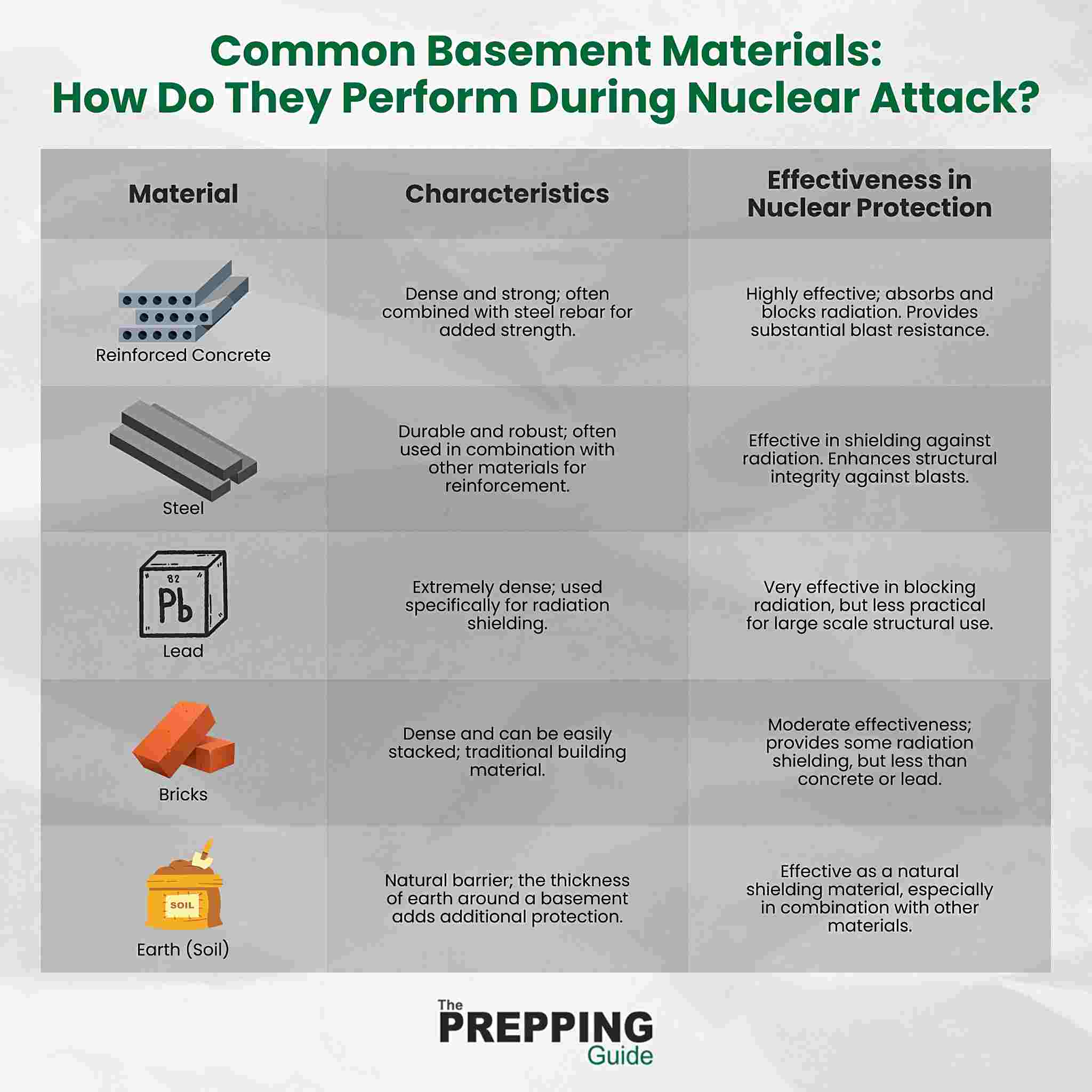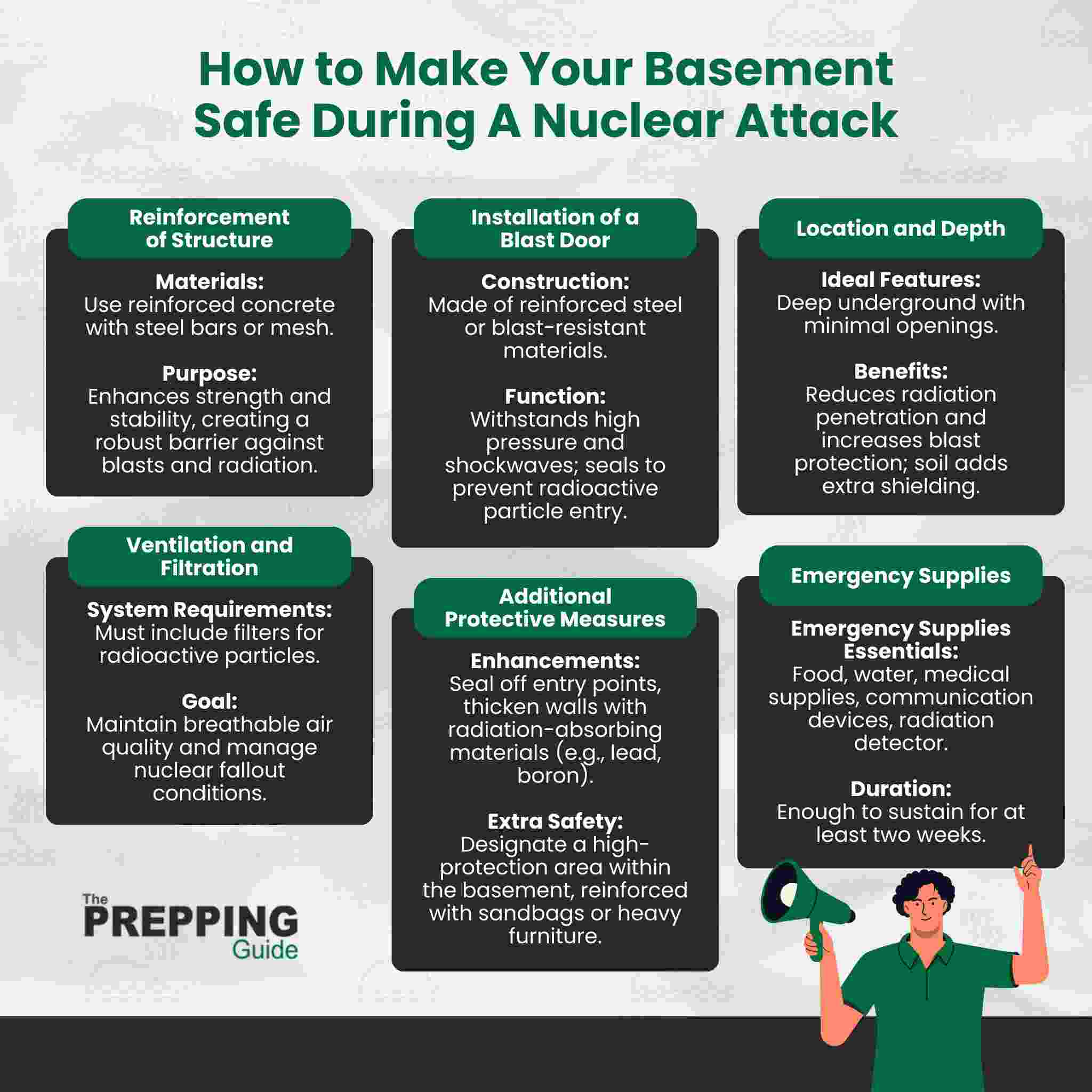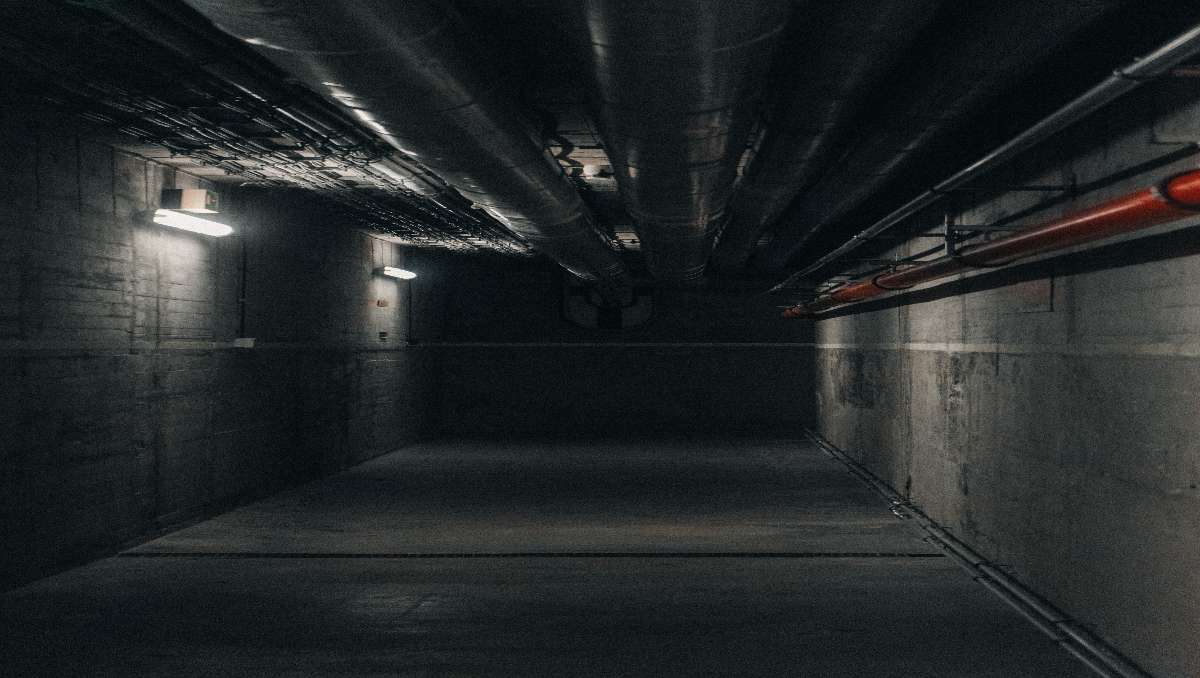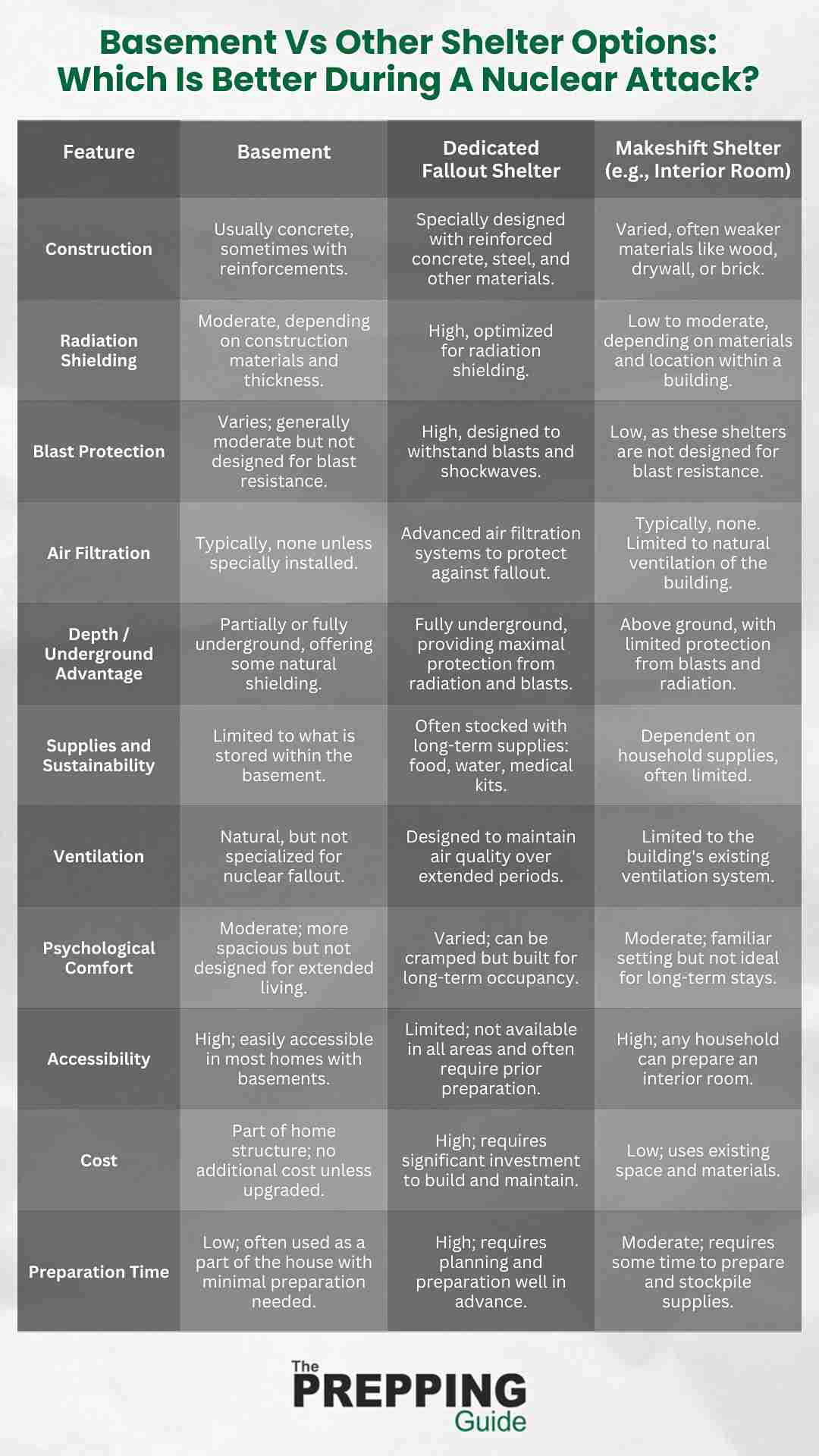Imagine a nuclear attack looming on the horizon. In such terrifying times, you may find solace in the idea that your basement could be your sanctuary, shielding you from the devastating effects of radiation. But can a basement protect you from a nuclear attack? Is it enough?
A basement can provide a degree of protection from a nuclear attack, particularly from the dangerous radioactive fallout, given its underground location. However, the level of protection greatly depends on the distance from the blast and the basement’s construction quality.
In this article, we will delve into the intricacies of nuclear attacks and explore whether your basement can serve as an effective refuge. We will guide you through essential pre-attack preparations to maximize your chances of survival.
The Protective Capacity of Basements Against Nuclear Radiation
Understanding the protective capacity of basements against nuclear radiation is crucial in preparing for a potential nuclear event. This section talks about the various factors that contribute to a basement’s effectiveness as a radiation shield, including construction materials, wall thickness, and depth.

Natural Shielding of Basements
Basements, by their very design, offer a form of natural shielding against nuclear radiation. Located below ground level, they are surrounded by earth, which provides a substantial barrier against harmful radioactive particles. The effectiveness of this natural barrier is enhanced by the construction materials used in the basement.
Concrete and steel are commonly used materials that are highly effective in absorbing and blocking radiation.
Concrete, in particular, is known for its dense nature, making it an excellent material for shielding purposes. The higher the density of the basement walls, the better they are at preventing radiation penetration.
The principle is simple: the thicker and denser the material, the more radiation it can absorb and therefore, the better the protection it provides.
Here’s an overview to help you understand the concept better:

Thickness of Basement Walls and Radiation Absorption
The thickness of the basement walls is another crucial factor. Thicker walls mean more material to absorb radiation, leading to better protection. Basements with walls that are 8 to 10 inches (20 to 25 centimeters) thick provide a significant level of protection, potentially reducing radiation exposure by up to 90%. However, this percentage can vary based on factors like the intensity of radiation and duration of exposure.
Proximity to Radiation Source and Basement Depth
The basement’s proximity to the source of radiation and its depth are also important considerations. A basement located further away from a nuclear explosion or a radiation leak is inherently safer. Additionally, the deeper the basement is buried, the greater the amount of earth available to serve as a barrier, enhancing its protective capacity.
Structural Requirements and Modifications for Optimal Protection
The threat of a nuclear war, though remote, presents a scenario where preparedness can be life-saving. One of the key aspects of this preparedness is understanding and implementing structural modifications and requirements that can make a basement a safer shelter during such an event.

Reinforcing the Basement Structure
The integrity of the basement structure is paramount in ensuring protection during a nuclear event. This involves reinforcing the walls, floor, and ceiling with materials that can withstand extreme conditions.
The use of reinforced concrete is highly recommended. Incorporating steel bars or mesh into the concrete significantly enhances its strength and stability, providing a sturdier barrier against blasts and radiation.
Considerations for the Underground Location
The effectiveness of a basement as a shelter is partially determined by its depth and location. Ideally, the basement should be located as deep underground as possible, with minimal windows or openings. Such a location minimizes the risk of radiation penetration and offers better protection against blast waves. The surrounding soil also adds an additional layer of natural radiation shielding.
Installation of a Blast Door
One of the most critical modifications for a nuclear-resistant basement is the installation of a blast door. This door should be constructed of reinforced steel or other blast-resistant materials, designed to withstand the high pressure and shockwaves of a nuclear blast. The door must seal tightly to prevent the entry of radioactive particles and provide a secure barrier against external threats.
Ventilation and Filtration System
In the event of a nuclear explosion, the air quality within the basement shelter becomes a significant concern. An effective ventilation system is crucial for providing a continuous supply of fresh air. This system should include filters capable of trapping radioactive particles, ensuring that the air inside the shelter remains safe to breathe. The filtration system must be robust enough to handle the demands of a nuclear fallout scenario.
Emergency Supplies and Equipment
Alongside structural modifications, it is essential to equip the basement with necessary emergency supplies and equipment. This includes a stockpile of food and water, medical supplies, communication devices, and a radiation detector to monitor radiation levels. These supplies should be sufficient to sustain occupants for a minimum of two weeks, the critical period following a nuclear blast.
Additional Protective Measures
Other measures to enhance the safety of a basement shelter include sealing off any potential entry points for radioactive particles, such as windows and vents. Thickening the walls with additional layers of radiation-absorbing materials, like lead or boron, can further increase the basement’s protective capacity. It’s also advisable to create a designated area within the basement that offers the highest level of protection, possibly by using sandbags or heavy furniture to create additional barriers.
In this video from The Truth You Need, learn how to plan, build, and stock your shelter, so your family can survive during a nuclear exchange.
How Long Can You Stay In Your Basement During a Nuclear Attack?
In the event of a nuclear attack, one of the most pressing questions for those seeking shelter in their basements is the duration for which it remains safe to stay there. This section discusses various factors that determine the safe duration of stay during a nuclear attack and provides insights into the complexities of nuclear fallout and radiation exposure.

Factors Influencing Safe Duration
Blast Intensity and Proximity to Ground Zero: The intensity of the nuclear blast and your distance from the explosion (ground zero) significantly affect radiation levels. The closer you are to the blast, the higher the radiation, necessitating a quicker evacuation or enhanced protection measures.
Design and Construction of the Basement: The protective capacity of your basement, influenced by its construction, materials, and depth, plays a crucial role. Basements with reinforced concrete walls and proper shielding can offer extended protection.
Radiation Levels: The level of radiation your basement is exposed to following a blast directly impacts how long you can safely stay. Basements further from the blast site may experience lower radiation levels, allowing for a longer stay.
General Guidelines for Duration
Initial Hours Post-Attack: The first 48 hours after a nuclear blast are crucial. Radiation levels are at their highest during this period. Staying in a well-shielded basement during these initial hours is highly advised.
Two-Week Rule: Experts often suggest that a minimum of 14 days in a shelter is necessary after a nuclear blast. This duration allows for the most dangerous and acute effects of initial radiation to diminish.
Monitoring Radiation Levels: The use of a Geiger counter or similar device to measure radiation levels is essential. If radiation levels within the basement begin to rise significantly, it may be time to seek better protection or evacuate, if possible.
The Role of Radiation Decay
The concept of half-life in radiation indicates that the intensity of radiation diminishes over time. This decay can influence how long you should stay in your basement. For instance, certain radioactive materials may see a significant reduction in harmful radiation after two weeks.
If you plan to stay in your basement for an extended period (beyond two weeks), it’s crucial to have enough supplies, including food, water, and medical kits, and to maintain an effective air filtration system.
Evacuation and Further Safety Measures
Continuous monitoring of news and radiation levels is vital to assess whether it’s safe to leave the basement. Be prepared with a plan for safe evacuation if the situation outside becomes safer than staying in the basement.
Is Hiding in A Bunker During A Nuclear War Safe?
In the context of a nuclear war, the concept of safety is relative and multifaceted. Bunkers, specifically designed for such scenarios, are often considered among the safest places one can be during a nuclear attack. However, the safety provided by a bunker depends on several factors, including its design, location, and the nature of the nuclear threat.
Design and Construction: Bunkers specifically designed for nuclear fallout are built with reinforced concrete and steel, offering protection against the blast and radiation. The thickness of the walls and the materials used play a crucial role in the bunker’s ability to shield its occupants from radiation.
Location and Depth: The depth of the bunker underground is a key factor in its safety. The deeper the bunker, the more earth there is to absorb and deflect radiation and blast waves. Also, the bunker’s proximity to the explosion site (ground zero) affects safety; the further away, the better.
Air Filtration and Ventilation: A well-designed bunker will have an advanced air filtration system to prevent radioactive particles from entering. This is crucial for maintaining breathable air and preventing contamination inside the bunker.
Supplies and Self-Sustainability: The bunker should be stocked with enough food, water, medical supplies, and other essentials for the duration of the occupants’ stay, which could be extended in the event of severe nuclear fallout.
Radiation Protection: In addition to physical protection from the blast, bunkers are designed to limit radiation exposure. This includes the use of materials that absorb or block radiation and the presence of radiation detection equipment to monitor levels.
Psychological and Social Considerations: The mental health of inhabitants is a crucial aspect. Long-term confinement in a small, enclosed space can lead to psychological stress, so the design and facilities within the bunker should consider the occupants’ mental well-being.
You might be interested in discovering essential strategies on surviving nuclear war without a bunker.
Basement Limitations and Alternatives

While basements can provide some protection from a nuclear attack, they may not suffice in some situations. It is crucial to consider alternative shelter options and compare the limitations of basements with other alternatives.
Basements have limitations, such as limited ventilation and the potential for collapse due to the weight of the building above.
In specific scenarios, seeking refuge in other types of shelters may be safer, such as specially designed underground bunkers or reinforced structures that offer better protection against radiation and structural damage.
Additionally, factors like proximity to ground zero and prevailing wind patterns can significantly impact the effectiveness of any chosen shelter. While basements can serve as a temporary refuge during a nuclear attack, it is essential to evaluate their limitations and explore non-basement alternatives for maximum safety and survival.
Alternative Shelter Options
Consider exploring alternative shelter options, such as specially designed underground bunkers or reinforced structures, which can be like a fortress against the destructive forces of a nuclear storm.
These underground bunkers are specifically built to withstand the immense pressure and heat a nuclear explosion generates. Equipped with advanced filtration systems, they can protect you from radioactive fallout and ensure a clean air supply for an extended period.
Also, hidden rooms within your home or backyard shelters can provide extra protection. Stocking these shelters with essential survival supplies like food, water, medical kits, and communication devices is crucial.
While basements may offer some protection during a nuclear attack, investing in more secure alternatives will significantly increase your chances of survival in such catastrophic events.
To give you an idea on which shelter option to consider, here’s a detailed comparison:

Fortified underground bunkers and specially designed structures offer higher security and survival during catastrophic events compared to traditional basement shelters. While basements can provide some protection, they are less secure than underground bunkers due to their location and construction.
Basements are typically located above ground, making them more vulnerable to the impact of a nuclear blast or fallout. Additionally, the materials used in basement construction may not be as resistant to radiation and debris as those in bunkers.
However, there are advantages to basement shelters. They’re generally more affordable than building or purchasing an underground bunker. Basements also benefit from being readily accessible from within your home, allowing for quick entry during an emergency.
However, it’s essential to consider the potential drawbacks of basement hideouts. These can include limited space, lack of ventilation systems, and potential structural weaknesses.
Basement Safety: In Retrospect
In conclusion, while a basement can provide some protection during a nuclear attack, it is vital to understand its limitations. Though it may shield you from initial radiation and debris, prolonged exposure to radioactive fallout poses risks.
Therefore, it’s crucial to follow government guidelines and recommendations for maximum safety. Remember, no shelter can guarantee complete protection, so stay informed and prepared. Prioritizing your safety during such an event requires patience, planning, and proper precautions.
